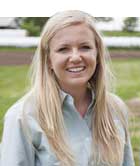
Sydney Sleep
Sydney Sleep grew up on her family’s Angus operation outside
of Spearfish, S.D. She is currently attending South Dakota State University
where she is pursuing a degree in agriculture communications. At college, Sleep
is an ambassador for the SDSU College of Agriculture and Biological Sciences,
is a member of Sigma Alpha professional agricultural sorority, and works as the
communications assistant for the College of Ag and Bio Director of Marketing
and Communications. She is serving as the 2016
Hay & Forage Grower summer
editorial intern.